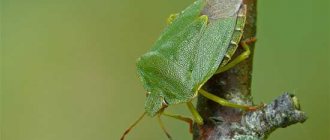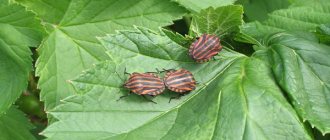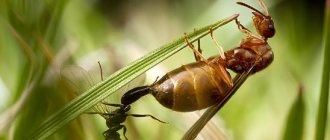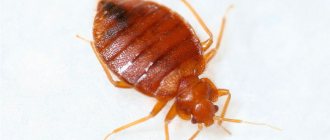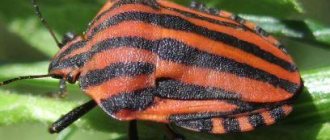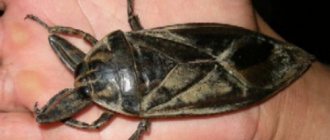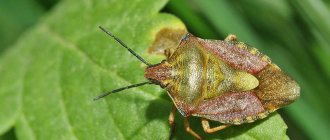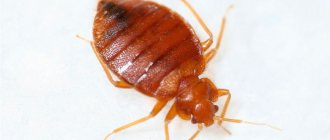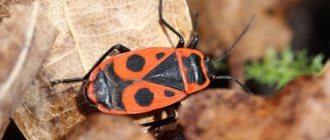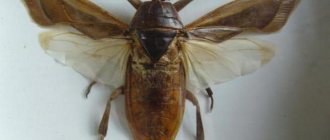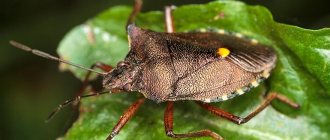There are many families and subspecies of bedbugs living in homes, gardens and wildlife, which cause problems in everyday life, as well as benefits and harm to human health.
One of the largest and most dangerous is the predator bug , distinguished by the diversity of its species of the Reduviidae family. Better known as the "killer beetle." It belongs to the family of the order Hemiptera or Arthroptera. There are more than 7,000 varieties of them in the world.
The size of bed bugs is large or medium, oblong and pear-shaped (body length 13-15 mm, the largest can grow up to 20 mm). The color of the insect depends on its habitat: it can be brighter than, for example, that of a hunting bug, or it can be darker and more monochromatic. Also, predator bugs can change color to a faded gray color - this is their defensive reaction when they detect danger. Their eyes are small and bulging; there are also eyeless species of predators. A distinctive feature of these bugs is their powerful short trunk, consisting of 3 segments, with which they pierce their prey. Females and males are similar in appearance, but it is possible that females may lack wings.
The legs of predators are long, the hind ones are much longer than the front ones, but they cling to prey using them.
Habitat
Like any other bedbugs, this species seeks out dark and dry places to live. Predatory bugs live almost everywhere: in trees, in grass, under stones, in nests and other structures slightly above soil or ground level. These can be forgotten termite mounds or cracks in the walls of clay houses.
They can be found in any country in the world, mainly in Malaysia, East Africa, South and North America.
What does it eat?
Judging by the name, it is clear that predatory bugs do not live on plants, but on other insects and their larvae, in particular ants. Others feed on flies and wasps. There are also types of predators living on the warm continent that feed exclusively on the blood of animals, including humans.
By nature, they are assiduous, able to wait for a target for a long time in a shelter and with one quick jerk pounce on it and dig into it with their proboscis, holding it with their short front legs. In actions and habits, they are similar to spiders. Using peculiar “spider” techniques, they can hunt even the largest and most cautious insects. Afterwards, the bugs fill the victim with poisonous saliva with an unpleasant odor - a substance that softens the insides of the insect, and then suck out the contents. The venom of a predatory bug is so strong that it can kill an insect larger than itself. The predator bug also secretes a special sticky substance, with which it attaches prey to its back. They use caught insects on their backs for camouflage and protection from enemies.
How we found out that we had bed bugs in our apartment - personal experience
We encountered the problem of bedbugs without even knowing it from the beginning. When we came to live in my husband's apartment, which was rented, we discovered cockroaches among the tenants. Of course, we renovated the apartment. The wiring was completely changed, including the sockets were moved, and the old ones adjacent to the neighbors were all sealed. True, when we did all these manipulations, we thought that we were getting rid of cockroaches, since before that we did not know that in our time bedbugs are found in quite a large city. We also sealed all the cracks, including in the ceiling; we also had adjacent cracks with neighbors in the wiring. There wasn't enough money for the floors; in our house they are wooden. We decided that we would fill all the holes and cracks in the floor and lay new linoleum on top, and that would be enough. Imagine my husband and I’s surprise when, six months later, while watching TV, we discovered some almost black dot, approximately 3 mm in size, on the light-colored wallpaper. We went up to see what it was sitting on the wallpaper, and didn’t have time to see anything, as someone rushed off faster. We didn’t attach any importance to this; we thought that maybe some cockroach had run in from the neighbors. The next morning, we discovered some red spots on our son’s leg, 3 of them, about 1 cm in size. At first we thought it was an allergy, but remembering the unknown creature on the wallpaper, we thought, maybe we HAD BUGS!!! Horror, we didn't know what to do. Now I’m calm, I couldn’t sit in front of the TV. We started dreaming about bedbugs at night. We even tried to find why bedbugs were dreamed of, but decided that first we needed to find the bedbug itself. We rummaged through all the sofas and cabinets, but found nothing there. We went through all the boxes in the pantry, but there was nothing there either. We climbed into the Internet and decided to read where else to look for the completely unnecessary new residents of our apartment.
How we were bitten by bedbugs
But we didn’t find any live reviews of how people fought bedbugs and where they looked for them. A week passed, during which time the spots on Maksimka’s leg disappeared. We didn’t seem to see bedbugs anywhere else, and in the places where we looked, we didn’t find them. We calmed down, maybe Maxim was just allergic, and there was a small cockroach on the wall, my husband and I told ourselves. But a month later we found out that the tenants were moving out from the apartment located below us. And so the owner of the apartment, vacated by the Kyrgyz, decided to destroy the bedbugs. He called a bedbug exterminator. Arriving home in the evening, we discovered bedbugs. And then we had a really quiet horror. They were everywhere. There was no need to even look for their hearth. The bugs crawled straight up the radiator, and then scattered along the walls and into the furniture, right in front of us, without even being afraid. Just like the scarabs crawling in the movie “The Mummy”. We could not imagine this even in our worst dreams. At a family council, we decided that we would spend the night in another room, and in the evening we would read how to get rid of bedbugs on the Internet. But in the morning we discovered many bites on the bodies of all family members, as well as bloody stains on the bed linen. The bed bugs finally got to us. We went into a room in which in the evening bedbugs crawled into our apartment along the radiators, they occupied the entire room (the room). There were bedbugs in the sofa, in the chest of drawers and everywhere. It was decided that today we would call a bedbug extermination service. I really didn’t want bed bugs to leave their eggs all over the apartment while we poisoned them with folk remedies. Towards evening, a man in overalls and with equipment for exterminating bedbugs came to us. He processed absolutely the entire apartment and said that it was impossible to spend the night in it. For 2 rooms We paid 2,400 rubles for the apartment. We seemed to calm down a little and went to spend the night with my grandmother. A day later we returned to the apartment, there were fewer bedbugs, but they did not disappear completely. After waiting another 3 days, we called the bedbug extermination service again. We were given another disinfection free of charge, under warranty. After spraying again, the bugs finally disappeared. A week after the bites, the bite marks disappeared. Now we have forgotten what house bugs are in an apartment. But at the slightest hint of their appearance in our house, we panic. Since we will never forget this invasion of house bugs.
Signs of appearance
Predatory bugs are more active at night. During the day they hide in dark and secluded places, and when darkness falls they go out to hunt.
You can spot them in an apartment or other outbuildings either by pure chance, or if there are insects in the house that they can feed on. Without prey in the form of cockroaches, flies and other insects, they have nothing to do in the apartment. If you do not allow these insects to enter the house, then it makes no sense for them to have predatory bugs living in the house.
REFERENCE! Their relatives, bed bugs, are quite common and actively reproduce in homes.
Reproduction
Bedbugs, like other parasitic insects, breed quickly. Female predator bugs lay about 2 dozen eggs, gluing them to plants or walls. After two months, larvae emerge from them and mature for about six months. In fact, the life cycle of adult bedbugs is about 2 years, but they usually live much less.
Larvae
At first, the color of the larvae is soft pink, then later the chest areas gradually darken and, ultimately, after molting, they acquire a completely saturated black-purple color. In some species, the larvae are covered with hairs, which help them collect dirt for camouflage and protection. Predatory bugs grow from 6 to 9 months.
Despite their unimpressive size, the hatched larvae are also predators and already run rapidly, hunting insects that match their height.
Harm and benefit
The predatory bug both causes harm and provides some benefit.
Harm
Since predatory bugs, unlike bed bugs, feed on other insects, they do not pose a great threat to people. But in any case, you need to behave extremely carefully with such insects. Even bedbugs that do not feed on animal blood can easily bite through human skin.
There are species of predators that pose an extreme threat to humans, as they carry serious diseases through their excrement.
The most dangerous representative is the triatomine bug . It is also called the kissing bug or "gentle killer" because of its distinctive bite on the face.
This representative does not live in Russia, but it can be found in South America. Gradually, these parasites reach the northern regions.
Benefit
While many garden bugs feed on vegetation and damage crops, some predatory bugs feed on these pests. In this way they are beneficial for those who fight against parasites in gardens and vegetable gardens.
What complications
Bedbugs carry the causative agent Chagas disease. The microorganism enters the wound along with the waste products of the parasite. The incubation period of the disease is 7-12 days. Severe swelling and inflammation appears in the damaged area. The skin is hard to the touch.
Lymph nodes enlarge. The infection does not spread until 4-6 weeks. There is a feeling of malaise, headaches, muscle weakness. Body temperature increases. The fever does not go away within 2 weeks.
An increase in temperature is often observed
There is a small rash on the skin. The liver and spleen increase in size. Heart failure develops. The likelihood of death increases. The prognosis for recovery in advanced stages is minimal.
Death is also possible in the initial stages of the disease. Due to a number of complications, a person is forced to reduce his activity.
Does it bite?
A predatory bug can bite only if it wants to protect itself from danger, that is, due to the negligence of the person himself. But there are bugs for which animal and human blood are the main prey for survival.
You should pick up the predator using tweezers and gloves, but even they can be pierced by the thick proboscis of the insect. Bedbugs are also capable of spraying their poison at a distance of up to 30 cm.
The bite itself is accompanied by unpleasant and even painful sensations. If preventive measures are not taken, the skin on the wound may rot. The tingling sensation in the infected area may last for about a day. Swelling can last from two to three days.
To prevent infection and neutralize the poison, you need to wash the affected area with baking soda. Do not touch or scratch the bite site; you can wash the wound with soap and water. You can also use ice to relieve swelling (you can use ice in a plastic bag or just a bottle of cold water).
Sometimes an allergic reaction may occur to a predator's bite , so you should monitor the vulnerable spot for a long time and take an antihistamine in time.
To protect yourself from contact with this insect, you should follow certain rules. For example, when going on a hike in the forest or in places where there is large vegetation, wear closed clothes and hats to avoid getting bedbugs on your body.
IMPORTANT! Do not use strong-smelling hygiene products before traveling outside the city, as they may attract these and other insects.
Also, for prevention purposes, always apply special chemicals against bedbugs. Avoid walking through thick, tall grass or bushy vegetation. You should absolutely not turn over stones or reach into holes and nests with your hands, as this is the usual habitat of predatory bugs. It is advisable to get out into nature during the daytime, since night is the time of hunting and searching for prey for predators.
What are the symptoms of a bite
Contact with insects should be avoided. The main symptoms of a bite are presented in the table.
| General characteristics | The dirty predator and the ringed one bite the most painfully. The bite is more like a hornet attack. The reaction to a bite appears instantly. Symptoms persist for 2-3 months. Tropical representatives cause severe consequences. |
| Symptoms | The main symptoms of a bite include: • swelling; • feeling of severe itching; • pain and redness of the skin; • loss of consciousness; • dizziness; • increased heart rate. |
Immediately after the bite, the skin begins to swell and hurt. The lesion site increases in size. There is a high probability of developing an allergic process. Redness and itching do not go away for several months, which causes severe discomfort to the person.
After a bite, an allergic reaction in the form of Quincke's edema is possible
Quincke's edema rarely occurs. Allergies are usually not serious. For a long period of time after the bite, symptoms may be completely absent. Chagas disease develops.
If you ignore a bite, the consequences are sad, even if the damage was caused by a herbivorous representative. Severe pain does not disappear throughout the day. The area will take a long time to heal.
Who can be confused with
The predator bug is a pretty large insect and stands out for its rich, deep coloring, but it can still be confused with other species and insects. Among those similar in appearance, we should mention the ground wasp, similar to the predator in its bright color and striped abdomen.
Below is a comparative table of the similarities of some representatives of predators:
| Name of the bug | Size | Body | Color | Eating | Habitat |
| Dirty predator | 16-19 mm | pear-shaped | black, dark brown, brown with reddish legs | insects | tropics, subtropics, homeland - Africa |
| Triatomic bug | Up to 20 mm | pear-shaped | black, dark brown with pronounced stripes on the body | blood of animals, including human | American tropics, Mexico, Central America |
Triatomine bugs (in Latin Triatominae) are the most dangerous representatives that feed on animal and human blood and carry diseases, including sleeping sickness. Predators are not the most popular of blood-sucking insects, but they can be confused with other species that also have poisonous saliva.
Description
A typical representative of the family of predators is the ringed predator - a rather large bug, 12-13 mm long. The color is predominantly black, shiny, the rim of the abdomen is bright red with black stripes, the thighs are red with black bases. On the head, shaped like a cylinder, there are thread-like antennae and bulging eyes. The short proboscis looks like an awl. There is a constriction across the front back that divides the body into two parts - a wide back and a narrow front. The legs of predators, especially the hind ones, are relatively long, but they move rather slowly.
Fighting methods
Let's consider methods of fighting bedbugs.
Chemical
For the prevention and control of bedbugs of any kind, chemical agents are the most effective.
The predator does not pose a threat to vegetation, but since they lay larvae on it, plant foliage must be treated on both sides with insecticidal agents of various classes of chemical compounds.
It should be remembered that parasites tend to adapt to chemical compositions, so the products need to be alternated. So, in the absence of other pests (cockroaches, flies), predators do not live in houses, and there is no need to remove them.
Mechanical
The easiest way to combat predatory bugs is to remove leaves. Bed bugs look for dark, dry places to live, and foliage is ideal for them to hide during the day.
Natural enemies
Certain species of predators are avid enemies of bed bugs. For dirty predators, jumping spiders are their natural enemies.
How do people themselves influence the development and spread of bed bugs?
Human habitations provide bedbugs with a place to live and access to a blood source. Bed bugs typically infest large buildings such as apartments, dorms, prisons and theaters, but they can also be found in individual hotel rooms and private homes. There is a common misconception that bed bug infestations only occur in poorly constructed and poorly maintained buildings with unsanitary conditions. However, this is a misconception. Modern building design promotes the spread of infestations by allowing bedbugs to move from room to room through central heating ducts.
People can help spread bed bugs from one place to another by transporting infested bedding, furniture, and packaging materials. An even more widespread spread involves traveler bugs traveling through contaminated clothing, luggage, and laptop computers. International traveler bugs from countries with severe bed bug infestations are arriving in hotel rooms, which is why bed bugs are on the rise worldwide. Linen bugs do not require unsanitary conditions and do not discriminate between economy rooms and luxury hotels. They only require a source of blood provided by humans and can exist in the cleanest hotels, motels, apartments and houses.
Interesting Facts
There are interesting facts about these bugs:
- the bug absorbs up to 5 ml of blood from its prey;
- Triatomine bugs are called kissing bugs because they bite their prey near the lips and eyes;
- More people died from the bite of “kissing bugs” than from all other insects (even malaria mosquitoes);
- dirty predators are so named because of the strange feature of their nature to collect dust and debris on hairs for camouflage and self-defense from enemies;
- Bedbugs are lethal not by their bite, but by the excrement they excrete in the process and contain trypanosomes.
Notes
- Life of animals. Volume 3. Arthropods: trilobites, chelicerates, trachea-breathers. Onychophora / edited by M. S. Gilyarov, F. N. Pravdin, ch. ed. V. E. Sokolov. — 2nd ed., revised. - M.: Education, 1984. - P. 233. - 463 p. — 300,000 copies.
- Striganova B. R., Zakharov A. A.
Five-language dictionary of animal names: Insects (Latin-Russian-English-German-French) / Ed. Doctor of Biology sciences, prof. B. R. Striganova. - M.: RUSSO, 2000. - P. 90. - 1060 copies. — ISBN 5-88721-162-8.
